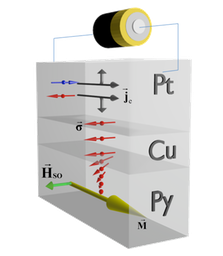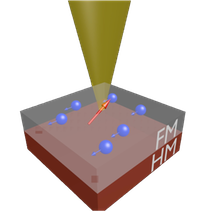
Spin-dependent electron transport in magnetic multilayer films
Besides charge, electrons also possess a quantum mechanical property called spin. Spin is a vector describing an angular momentum, with a quantized magnitude of ħ/2. In many cases the spin angular momentum averages out in solids. However, both exchange and spin-orbit interactions can lift the spin degeneracy and result in a flow of spin current. A spin current carries angular momentum. Because magnetization arises from an ensemble of electron angular momentum, the spin current can efficiently interact with magnetization through the transfer of angular momentum. This enables a convenient way to manipulate magnetization with electric current.
We study how the electron spin interacts with magnetization, crystal orbitals and lattices in the presence of exchange and spin-orbit interactions. The tools to facilitate this study involve magneto transport, microwave resonance, optical and X-ray techniques.
Microwave and light interaction with magnetism

Similar to electrons, electromagnetic wave, i.e. photons, also carry a spin angular momentum of ħ. Therefore, the EM wave also interacts with magnetization. In particular, EM waves at GHz frequency, also known as microwaves, can resonate with magnetization. The so-called ferromagnetic resonance can be used to assess magnetic properties of a material, as well as for applications in communication devices such as microwave absorbers. Another well-known interaction between EM waves and magnetization is the magneto-optic-kerr-effect (MOKE). The MOKE describes the change of light polarization upon reflection from a magnetic object that results from angular momentum transfer between the light and the magnetization. The MOKE effect can therefore be a convenient tool to study the magnetization of materials. Its inverse effect can be used to control magnetization with lasers.
We study how microwaves and visible light interact with magnetization, with a specific focus on the role of spin-orbit interactions throughout this process.